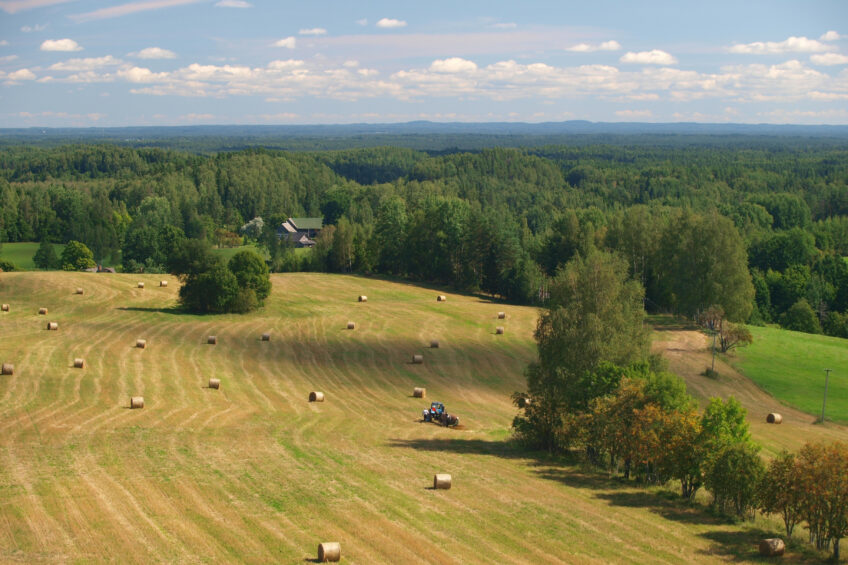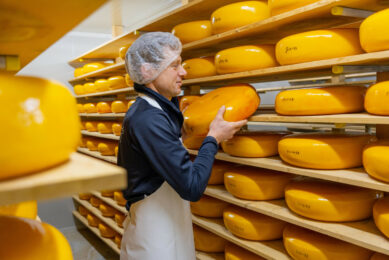Estonia’s ambitious plans for dairy

Agriculture is deeply rooted in the Estonian tradition, but small dairy farms make room for large-scale dairy operations. Fuelled by several advantages, such as affordable land, this Baltic country has enough potential to soon become the EU’s most cost-efficient milk producer.
Estonia, the northernmost of the 3 Baltic countries, is pretty much covered with forest (around 50%). Farmland represents around 21% of the country. With a population of approximately 1.3 million people (the least dense populated Baltic country), people might easily think this tree-covered country plays an insignificant role in the European Union (EU) when it comes to agriculture. But nothing can be further from the truth. Agriculture is deeply rooted in Estonia and over the last decade or so, the dairy sector has seen dramatic changes, fuelled by relatively low agricultural land prices, new investors and commitment from the Estonian government. “The dairy sector in Estonia has been modernised and has expanded since joining the EU in 2004. Since then, a huge increase in milk output has been witnessed. From an average milk yield of 5,600kg per cow per year in 2004 to 8,600kg in 2015,” explains Joakim Helenius, chairman and founder of Trigon Dairy Farming, Estonia’s biggest milk producer. This jump in milk output is much bigger than the increase seen in other EU member countries, although all EU countries show solid improvements. In Denmark for example, milk production increased from 8,000kg in 2004 to 9,300kg in 2015. Also Lithuania and Latvia have shown increased outputs per cow (+38% and +43% respectively).

Spike in farm size
So why is Estonia such an extreme case when it comes to stepping up milk output over the last years? “Actually, the transformation of the Estonian farming sector started almost 30 years ago,” explains Ants-Hannes Viira, head of the Institute of Economics and Social Sciences at the Estonian University of Life Sciences. In the 1990s, the structure of Estonian agriculture was completely changed due to restitution of agricultural land and farmsteads to the owners or their heirs who owned these plots of land before the second World War. This was followed by privatisation of collective and state farms. In this period, also many started new farms from scratch. But market conditions were bad and almost no investments were made in agriculture. Dairy farmers therefore struggled. “The EU accession in 2004 brought a significant change. Estonian agricultural policy prioritised investments, environment and diversification of rural economy after the EU accession. Also, the conditions for getting credit improved significantly after 2004,” Mr Viira explains. As a result, Estonia went through a dramatic increase in farm size over the last years. Between 2000 and 2015 the average number of cows per farm in Estonia spiked from 32 cows to 136 cows.
Currently, this puts Estonia in second place, after Denmark with an average farm size of 152 cows per farm. On a global level, New Zealand tops the list with 413 animals on average per farm. “From experience we know that larger farms have a higher milk production. Look at successful dairy export countries like the US and New Zealand. They have large average dairy farms, which enables more efficient operations and tighter supply chains,” says Mr Helenius from Trigon Dairy Farming. If we look at Estonia, we see an average milk yield of over 10,000kg for farms over 600 cows, compared to 7,200kg for farms smaller than 100 head of cattle and 9,400kg for farms between 100 and 600 cows. So size does matter when it comes to production efficiency. The increase in farm size is not a specific trend seen in Estonia alone. In the whole EU, farms are becoming bigger and a rapid decline in the number of smaller dairy farms is what we have seen everywhere over the last years.

“The dairy sector in Estonia has been modernised and expanded fast since joining the EU in 2004,” says Joakim Helenius, chairman and founder of Trigon Dairy Farming. Photo: Emmy Koelmean
Targeting nearby markets
Estonian dairy farmers currently produce around 714,000 tonnes of milk annually, which corresponds to 2,000 tonnes per day. Around 25% of this volume is exported, mainly to neighbouring countries. Milk prices in Estonia are relatively higher than in the nearby Lithuania. According to Helenius, this is because milk processors prefer collecting milk from bigger farms (seen in Estonia), instead of dealing with the logistical challenge and mixed quality from collection at smaller farms (seen in Lithuania). The hassle associated with collection means a lower price for the Lithuanian dairy farmers. Also cost price in Estonia is favourable because land is still affordable. Mr Helenius explains: “When buying land, it should make economic sense. In the Netherlands you would easily pay € 50,000 per hectare (ha). Currently, a hectare of good quality agricultural land in Estonia rates between € 3,500-4,000. Adding the latter figures is much more attractive when investors look at the total picture.” This, in combination with the relatively good milk prices, have led to an export value of Estonian dairy products valuing € 144 million in 2016.
Estonia’s main export products were:
- cheese (€ 50 million)
- raw milk (€ 49.6 million)
Estonia has potential to take a percentage of Finnish and Swedish market
According to Joakim Helenius, Estonia has potential to take a certain percentage of the Finnish and Swedish market. “The costs associated with the production of 1kg milk in Estonia are € 0.10 to € 0.15 lower than in Finland. Why should Finland maintain its current level of milk production, generated by small, less efficient farms, if you could buy cheaper milk from Estonia? If, in theory, Estonia can take 10% of the Finnish and Swedish market, it means an extra 1,600 tonnes we should produce per day, on top of the current 2,000 tonnes. This is possible,” he believes. To be able to do this, more processing facilities should arise in Estonia. Recently, a new processing plant from E-Piim Cooperative received € 15 million in state subsidy. This plant, with a full capacity of 1,000 tonnes per day, is planned in the Estonian town Paide and expected to be up and running in 2020-2021. Coop E-Piim already has 2 processing sites and they have oriented to the export of dairy products (cheese, milk and whey powders, butter).
Tiina Saron, deputy secretary general of the Estonian Chamber of Agriculture and Commerce, agrees that Estonia has favourable preconditions for milk production. “There is demand for Estonian milk products by nearby markets. The strategic goal is to convert those preconditions into moderate growth, which means adding a third to the present domestic production. In addition, Estonia should use the opportunity to increase product value. This will provide additional income for farmers, who want to sell products both on the domestic market as well as abroad,” she adds.

EU subsidies: From nothing to something
When entering the EU, the EU agricultural subsidies become available. For Estonia these are still relatively low compared to Western European countries. Obviously, the subsidies have already been determined for the period 2014-2020. In 2016, Estonia received € 115 per ha. This will increase to € 163 per ha in 2020. Discussions regarding the actual level of subsidies in the next EU budget period (2021-2027) will start in late 2017 and if it is up to the Estonian Chamber of Agriculture and Commerce, farmers in the EU should be treated equally, so also in terms of subsidies. “Our association is involved in the discussions concerning future CAP and we are also members of Copa-Cogeca, EDA and Eucolait in Brussels. All these efforts are aimed at boosting our dairy sector strategy,” explains Ms Saron.
Estonia has sights on equal subsides for all EU stats after 2020
It might be advantageous that Estonia is currently president of the EU council (July-December 2017). During the planned meetings with the other EU institutions, Estonian representatives will certainly bring the agricultural subsidies after 2020 to the table. Helenius from Trigon Dairy Farming explains: “We hope that the subsidies per hectare will be gradually equalised among the member states. In the future, no farmer should be below the 90% EU average. Because we don’t get a lot of subsidies, farmers are now used to producing in a cost-efficient manner. I believe that the Estonian dairy sector will be given an extra boost when subsidies per hectare are gradually improved over the next ten years. In the meantime, it is also a good thing that our farmers are not too much dependent on subsidies. The dairy sector is a market driven business, and if Europe wants to stay an efficient producer, it cannot rely purely on subsidies.”
2020 strategy: So what will the future be for the Estonian dairy sector?
5 years ago, a strategic plan for the dairy sector was made. The so-called ‘Estonian dairy strategy 2012-2020’ was signed by the Estonian Ministry of Agriculture, the Estonian Dairy Association (now merged into the Estonian Chamber of Agriculture and Commerce), the Estonian Farmer’s Federation, the Central Union of Estonian Farmers and the Estonian Chamber of Agriculture and Commerce in the year 2012. “We started the preparations of this paper in 2009, just before the dramatic fall in milk prices. Initially, the main goal was how to cope with the crisis. Later, we focused more on future developments and challenges of the Estonian dairy sector,” says Ms Saron. The paper also contained some recommendations for the Rural Development Plan (RDP), which was being prepared at that time. Amongst others, the Estonian Dairy Association addressed the need for better cooperation between farmers and processors and fostering cooperative development and vertical cooperation. Steps have certainly been made in this area, as in 2017 a € 15 million grant was given to dairy cooperative E-Piim from the Estonian government to build a new dairy processing plant.
“Nevertheless, the main goal of our 2020 strategy hasn’t been reached yet. Due to the last dairy crisis (2015-2016), dairy farmers really struggled and we still feel that we are in the recovery mode from this,” explains Ms Saron. For Trigon Dairy Farming, the future will be marked by further growth and further focus on cost-efficient production of milk. Mr Helenius states, “We have come from some difficult years, with milk prices of € 0.2307 on average in the last few years. But the market looks brighter now and we have room to grow. I strongly believe that Estonia can become one of the fastest growing players on the European market in the near future.”

Will Estonia become the EU’s top milk producer?
Mr Viira from the University of Life Sciences in Estonia, predicts that many Estonian farms will further upscale in the upcoming years. “Growing from 500 to 1,000 cows is not so difficult, given the fact that the land is there for forage production. But even though Estonia can produce in a cost-efficient way, through the abundance of land, the prices for agricultural land are increasing rapidly,” Mr Viira explains. He continues: “Compared to the subsidies that are available to Estonian farmers, their costs on land rent, labour and interests (to serve the loans taken for investments) are above the EU-28 average. In addition, the Estonian government supplied lower extra financial support for farmers during the dairy crisis, compared with neighbouring countries. The need for Estonian dairy farmers to control costs, optimise feeding and control herd health, will therefore become more stringent in the coming years.” The Estonian University of Life Sciences is contributing to this and is involved in several projects that aim to improve the productivity of dairy cows and farms. The projects are related to breeding, animal health, feeding, milking and farm performance benchmarking. So will this all lead to a situation where Estonia is the biggest milk producer in the EU? In total volume probably not, but they will in milk yield per cow. “But frankly, I think that farmers should prioritise profit over yield, which is already at a top level,” says Mr Viira. Helenius from Trigon Dairy Farming agrees. “Our company does not want to be the biggest producer per se, but we aim to be the most cost-efficient one.”
Join 13,000+ subscribers
Subscribe to our newsletter to stay updated about all the need-to-know content in the dairy sector, two times a week.










